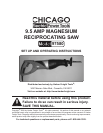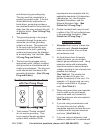
SKU 97580 For technical questions, please call 1-800-444-3353. Page 7
and three prong grounding plug.
The plug must be connected to a
properly grounded outlet. If the tool
should electrically malfunction or
break down, grounding provides a
low resistance path to carry electricity
away from the user, reducing the risk
of electric shock. (See 3-Prong Plug
and Outlet.)
The grounding prong in the plug is 2.
connected through the green wire
inside the cord to the grounding
system in the tool. The green wire
in the cord must be the only wire
connected to the tool’s grounding
system and must never be attached
to an electrically “live” terminal. (See
3-Prong Plug and Outlet.)
The tool must be plugged into an 3.
appropriate outlet, properly installed
and grounded in accordance with all
codes and ordinances. The plug and
outlet should look like those in the
preceding illustration. (See 3-Prong
Plug and Outlet.)
Double Insulated Tools: Tools
with Two Prong Plugs
Tools marked “Double Insulated” 1.
do not require grounding. They
have a special double insulation
requirements and complies with the
applicable standards of Underwriters
Standard Association, and the
National Electrical Code. (See
Outlets for 2-Prong Plug.)
Double insulated tools may be used 2.
in either of the 120 volt outlets shown
in the preceding illustration. (See
Outlets for 2-Prong Plug.)
Extension Cords
Grounded1. tools require a three wire
extension cord. Double Insulated
tools can use either a two or three
wire extension cord.
As the distance from the supply 2.
outlet increases, you must use a
heavier gauge extension cord. Using
extension cords with inadequately
sized wire causes a serious drop in
voltage, resulting in loss of power and
possible tool damage.
(See Table A.) The smaller the
gauge number of the wire, the
greater the capacity of the cord. For
example, a 14 gauge cord can carry
a higher current than a 16 gauge
cord. (See Table A.)
When using more than one extension 3.
cord to make up the total length,
make sure each cord contains at
least the minimum wire size required.
(See Table A.)
If you are using one extension cord 4.
for more than one tool, add the
nameplate amperes and use the sum
to determine the required minimum
cord size. (See Table A.)
If you are using an extension cord 5.
outdoors, make sure it is marked with


















